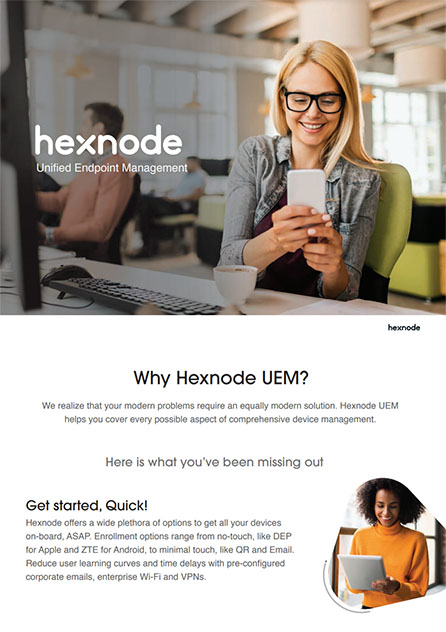Custom app configurations for Mac: A deep dive
Custom app configurations for Mac are made by editing a property list file. This file holds the info that the system uses which determines how the app

Get fresh insights, pro tips, and thought starters–only the best of posts for you.
Arthur Harrison
Dec 23, 2021
6 min read

Labeling stuff is important, whether it be your kitchen condiments or the IT assets of your organization. They allow us easy access to the necessary items/devices when needed. Device attributes, which are important for dynamic parameters, typically contain the device info. These help both in labeling the said device as well as grouping. Moreover, they make policy associations simpler either individually or in bulk.
Some of the common device attributes are:
UEMs like Hexnode takes things even further with dynamic parameters, making policy associations even easier.
Dynamic parameters store custom information about the device. Based on the attribute you choose, the respective info about the device will be used. This lets you take actions or associate policies in bulk without needing to enter the device info for each manually.
To begin with, let’s say you are the IT admin, and you want to send a custom message to all your devices like,
Hi [user], this device is currently being managed by your organization.
Customizing each message can be tedious. Instead, you can simply use the “%name%” attribute. These dynamic device attributes are also called the ‘wildcards’. The new message will be
Hi %name%, this device is currently being managed by your organization.
The message the users will receive will be customized even when the exact same text in quotes above is sent to all of them.
Steve will see the message as,
Hi Steve, this device is currently being managed by your organization.
But on Laura’s device it will be,
Hi Laura, this device is currently being managed by your organization.
Hence, they are “dynamic” parameters.
We realize that your modern problems require an equally modern solution. Hexnode UEM helps you cover every possible aspect of comprehensive device management. Refer to the brochure to know more about UEM features.

Featured resource
Why Hexnode UEM
They are useful in many different ways:
Like I had mentioned before, you could broadcast messages to a bulk of devices at once and each of them will receive a customized version of the sent message.
They are also helpful in configuring the lock screen messages. For example, having the asset details or contact info visible without unlocking makes the device retrieval and identification fruitful.
Connecting devices to secure networks is essential for any organization, but it will be a tedious job for the IT department to connect each device to the network. They can’t make employees connect their devices themselves because that raises security concerns. So, wi-fi policies are configured and pushed to the devices which helps devices connect to the required wi-fi network automatically. Although this is great, for more security, some protocols require user authentication and using wildcard variables, you can fill in the appropriate user information mapped to the device.
Not just for wi-fi, you can also provide user details for authentication while setting up the VPN and also the APN for your device.
In general, configuring an email account is straightforward with a capable UEM solution like Hexnode. While doing so, you need to give the user details like user email and username. If similar configurations apply for multiple email accounts, instead of providing info separately for every user, you could use %email% and %username% to populate the respective areas. Apart from that, you could also create new user accounts

In Android, while configuring apps, as usual, you can fill the required information using the dynamic parameters. However, in iOS and macOS, remote app configurations are made using an XML script file. You can still use the wildcards in the script file to give the necessary info required for configuring the app. For example, you could use the username, email, and other info to create a new user account in supported managed apps.
Further, similar to app configurations, device configurations in iOS and macOS are made using XML files. Therefore, wildcards can be used in configuring the device as well.
In conclusion, dynamic parameters help customize the policies and actions you want to implement on required devices. They make tasks like broadcasting texts, configuring accounts and networks, and custom scripts less tedious for the IT staff. Moreover, Hexnode’s good support for wildcards is a value add for any organization.